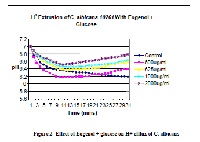Effect of Eugenol in presence and absence of nutrients (glucose and Xylose) on H+ATPase of C. albicans.
Keywords:
H ATPase, MIC and C. albicansAbstract
Candida albicans is an Opportunistic human pathogen causes both superficial and life threatening mycoses fatal for immuno comprised patients. Many essential oils of spices possess antimycotic properties. The electrochemical gradient generated by PM-H+ATPase of C. albicans drives nutrient transport. H+ ATPase is associated with yeast to hyphal transition, later form being more pathogenic. It is thus important to identify spice extracts which apart from having low MIC also have a profound effect on H+ ATPase. With this in view we have investigated Eugenol alone and along with nutrients (xylose and glucose) on H+ ATPase functioning through H+ extrusion measurement. The antifungal activity of Eugenol alone and along with nutrients (xylose and glucose)was investigated by studying their effect on PM-ATPase mediated H+-Extrusion activity (H+ efflux) and growth of C. albicans (Disc diffusion and MIC).Eugenol inhibited the H+ ATPase as observed by H+ efflux monitored for 30 min. The oil has clear inhibitory effect on H+ efflux in the concentration range of 500µg/ml to 2000µg/ml. Eugenol has an inhibitory effect on growth and H+-Extrusion of H+ ATPase of C. albicans. Both glucose and xylose along with Eugenol have inhibitory effect on Candida growth but no such effect has been observed on H+-ATPase pump of the fungus. Eugenol has a potential to be exploited as future antifungal drug to target plasma membrane H+ ATPase of C. albicans and other pathogenic microbes.
References
. Odds F C [1985] Morphogenesis in
Candida albicans CRC Crit Rev
Microbiol, 12:45-48
. D'Souza CA, Heitman J. Conserved
cAMP signaling cascades regulate
fungal development and virulence.
FEMS Microbiol Rev. 2001
May;25(3):349-64.
. Odds F C [2005] Genomics, molecular
targets and the discovery of antifungal
drugs. Rev Iberoam Micol 22:229-237.
. Carrillo-Muñoz AJ, Giusiano G,
Ezkurra PA, Quindós G. Antifungal
agents: mode of action in yeast
cells.Rev Esp Quimioter. 2006
Jun;19(2):130-9.
. Chami N, Chami F, Bennis S, Trouillas
J and Remmal A [2004] Antifungal
treatment with carvacrol and Eugenol
of oral candidiasis in
immunosuppressed rats. Braz J Infect
Dis 8 (3): 217-226.
. Lingrel JB, Kuntzweiler, T: Na+,K+-
ATPase. J. Biol. Chem. 1994,
:19659-19662
. Sheets, M., Wu, M., and Wickens, M.
(1995). Polyadenylation of c-mos
mRNA as a control point in Xenopus
meiotic maturation. Nature 374, 511–
. Soteropoulos P, Vaz T, Santangelo R,
Paderu P, Huang DY, Tamas MJ,
Perlin DS Manzoor N, Amin M and
Khan LA [2002] Effect of
Phosphocreatine on H+ extrusion, pHi
and dimorphism in Candida albicans In
J Exp Biol 40:785-790.
. Monk, B. C.; Mason, A. B.;
Abramochkin, G.; Haber, J. E.; SetoYoung, D.; Perlin, D. S. (1995) The
yeast plasma membrane proton
pumping ATP-ase is a viable antifungal
target. I. Effects of the cysteinemodifying reagent omeprazole.
Biochem. Biophys. Acta, 1238, 81-
. Setoyoung D, Monk B, Mason AB,
Perlin DS [1997] Exploring an
antifungal target in the plasma
membrane H+ ATPase of fungi.
Biochim Biophys Acta-Biomembranes
:249-256.
. Perlin DS. Antifungal drug
resistance: do molecular methods
provide a way forward? Current
Opinion in Infectious Diseases 2009,
:568–573
. Perlin DS. Ion pumps as targets
for therapeutic intervention: Old and
new paradigms EJB Electronic Journal
of Biotechnology Vol.1 No.2, Issue of
August 15, 1998
. Monk, B. C., Feng, W. C.,
Marshall, C. J., Seto-Young, D., Na, S.,
Haber, J. E. and Perlin, D. S. (1994).
Modeling a conformationally-sensitive
region of the membrane sector of the
fungal plasma membrane proton
pump. Journal of Bioenergetics and
Biomembranes 26: 101-115.
. Newall CA, Anderson LA and
Phillipson JD [1996] Herbal Medicines.
A Guide for Healthcare Professionals
Effect of Eugenol on growth and
Listeriolysin O production by Listeria
monocytogenes the Complete
Commission E Monographs,
Therapeutic Guide to Herbal
Medicines. Boston, Mass: Integrative
Medicine Communications; 1998:110.
. Wang SY, Chen PF, Chang ST
Antifungal activities of essential
oils and their constituents from
indigenous cinnamon (Cinnamomum
osmophloeum) leaves against wood
decay fungi. Bioresour Technol. May;
(7): 813-8
. Knoblack K., pauli A.,Iberl N., et
al. [1989] Antibacterial and antifungal
properties of essential oil components
J Essent Oil Res 1:119-28
. Nenoff P,Haustein U.F., Brandt
W. [1996] Antifungal activity of the
essential oil of Melaleuce alternifolia
(tea tree oil) against pathogenic fungi
in vitro. Skin Pharmacol .9(6): 388-94.
. Singh HB, Srivastava M, Singh
AB, Srivastava, AK. [1995] Cinnamon
bark oil, a potentfungitoxicant against
fungi causing respiratory tract mycoses
Allergy. 50:995–9
. Azumi S, Tanimura A, Tanamoto
K. [1997] A novel inhibitor of bacterial
endotoxin derived from cinnamon
bark. Biochem Biophys Res. Commun.
:506–10
. Quale J M, Landman D, Zaman M
M. [1996] In vitro activity of
Cinnamomum zeylanicum against
azole resistant and sensitive Candida
species and a pilot study of cinnamon
for oral candidiasis. Am J Chin Med ;
:103–109.
. Lidia Núñez; Miguel D, Aquino;
Jorge [2001] Chirife antigyngal
properties of clave oil (Eugenia)
caryophylata) in sugar solution Braz. J.
Microbiol. vol.32 no.2 São Paulo.





